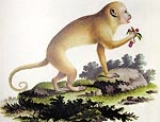
Blond Capuchin
Encyclopedia
The blond capuchin is a species of the Cebus apella group in capuchin monkey
s, the genus Cebus. This critically endangered
species was rediscovered in 2006. It is endemic to northeastern Brazil
, and it is estimated that only about 180 individuals remain.
in 1648. In 1774 Johann Christian Daniel von Schreber
posited Simia flavia as an independent species, but it had long lacked any specimen. It was not until in 2006 when researchers made its neotype designation. In their neotype designation article, de Oliveira and Langguth confirmed the consistency of Marcgrave’s, Schreber’s, and their capuchins, attributed the authority to Schreber, and established a new combination of its scientific name, C. flavius Schreber, 1774.
In the same year, 2006, Mendes Pontes and Malta reported C. queirozi as a new species. However, de Oliveira and his collaborators pointed out the existence of the previous studies, that is, those of Marcgrave and Schreber as well as the inadequacy of Mendes Pontes and Malta's designation of the type specimen, and therefore considered C. queirozi to be a junior synonym. Rylands and Mittermeier
followed de Oliveira and Langguth’s view.
, Pernambuco
, and Alagoas
in the northeastern part of Brazil
.
Capuchin monkey
The capuchins are New World monkeys of the genus Cebus. The range of capuchin monkeys includes Central America and South America as far south as northern Argentina...
s, the genus Cebus. This critically endangered
Critically endangered
Version 2010.3 of the IUCN Red List of Threatened Species identified 3744 Critically Endangered species, subspecies and varieties, stocks and subpopulations.Critically Endangered by kingdom:*1993 Animalia*2 Fungi*1745 Plantae*4 Protista-References:...
species was rediscovered in 2006. It is endemic to northeastern Brazil
Brazil
Brazil , officially the Federative Republic of Brazil , is the largest country in South America. It is the world's fifth largest country, both by geographical area and by population with over 192 million people...
, and it is estimated that only about 180 individuals remain.
Classification
The blond capuchin was first described as “caitaia” by Georg MarcgraveGeorg Marcgrave
Georg Marcgrave was a German naturalist and astronomer.- Life :Born in Liebstadt in the Electorate of Saxony, Marcgrave studied botany, astronomy, mathematics, and medicine in Germany and Switzerland until 1636 when he journeyed to Leiden in the Netherlands.In 1637, he was appointed astronomer of...
in 1648. In 1774 Johann Christian Daniel von Schreber
Johann Christian Daniel von Schreber
Johann Christian Daniel von Schreber , often styled I.C.D. von Schreber, was a German naturalist.-Career:He was elected Professor of Materia medica at the University of Erlangen in 1769....
posited Simia flavia as an independent species, but it had long lacked any specimen. It was not until in 2006 when researchers made its neotype designation. In their neotype designation article, de Oliveira and Langguth confirmed the consistency of Marcgrave’s, Schreber’s, and their capuchins, attributed the authority to Schreber, and established a new combination of its scientific name, C. flavius Schreber, 1774.
In the same year, 2006, Mendes Pontes and Malta reported C. queirozi as a new species. However, de Oliveira and his collaborators pointed out the existence of the previous studies, that is, those of Marcgrave and Schreber as well as the inadequacy of Mendes Pontes and Malta's designation of the type specimen, and therefore considered C. queirozi to be a junior synonym. Rylands and Mittermeier
Russell Mittermeier
Russell Alan Mittermeier is a primatologist, herpetologist and biological anthropologist. He has written several books for both popular and scientist audiences, and has authored some 300 scientific papers.-Biography:...
followed de Oliveira and Langguth’s view.
Distribution
This species inhabits the northeastern Atlantic Forest extended in the states of ParaíbaParaíba
Paraíba Paraíba Paraíba (Tupi: pa'ra a'íba: "bad to navigation"; Brazilian Portuguese pronunciation: is a state of Brazil. It is located in the Brazilian Northeast, and is bordered by Rio Grande do Norte to the north, Ceará to the west, Pernambuco to the south and the Atlantic Ocean to the east...
, Pernambuco
Pernambuco
Pernambuco is a state of Brazil, located in the Northeast region of the country. To the north are the states of Paraíba and Ceará, to the west is Piauí, to the south are Alagoas and Bahia, and to the east is the Atlantic Ocean. There are about of beaches, some of the most beautiful in the...
, and Alagoas
Alagoas
Alagoas is one of the 27 federative units of Brazil and is situated in the eastern part of the Northeast Region. It borders: Pernambuco ; Sergipe ; Bahia ; and the Atlantic Ocean . It occupies an area of 27,767 km², being slightly larger than Haiti...
in the northeastern part of Brazil
Brazil
Brazil , officially the Federative Republic of Brazil , is the largest country in South America. It is the world's fifth largest country, both by geographical area and by population with over 192 million people...
.

